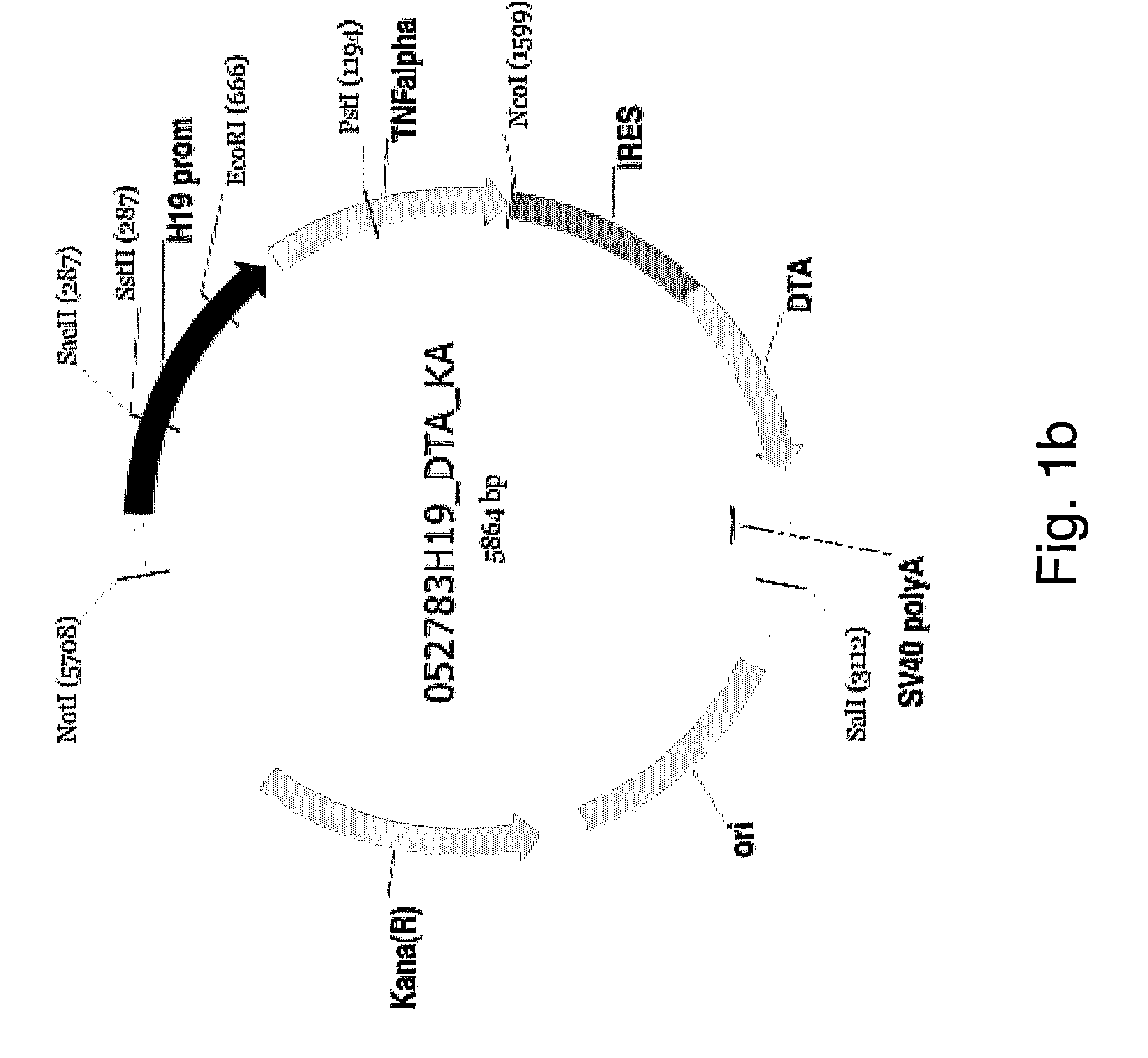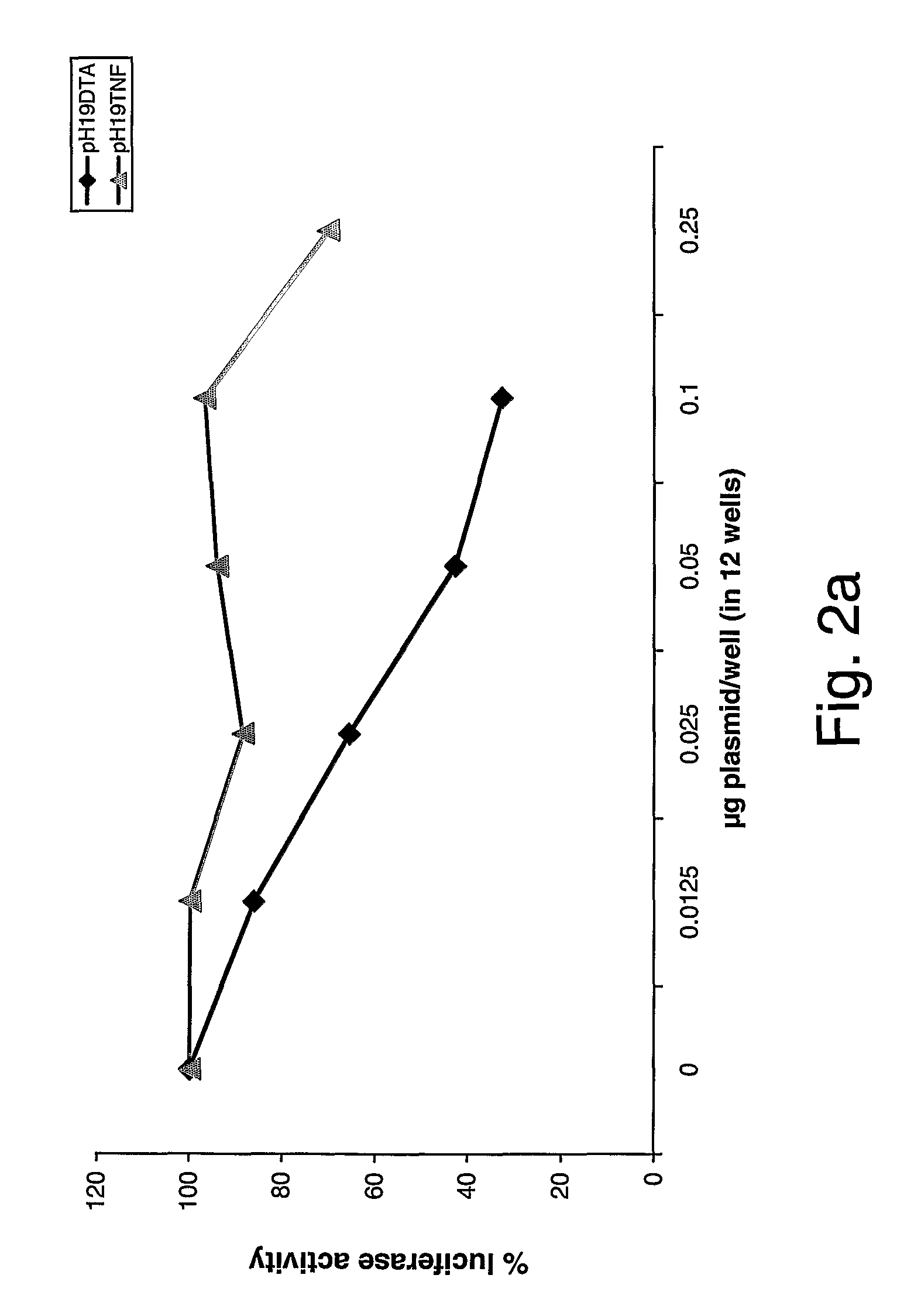Nucleic acid constructs, pharmaceutical compositions and methods of using same for treating cancer
a technology of nuclear acid and constructs, applied in the field of nuclear acid constructs, can solve the problems of individual death, tumor enlargement and occupying vital space, and affecting the control mechanism
- Summary
- Abstract
- Description
- Claims
- Application Information
AI Technical Summary
Problems solved by technology
Method used
Image
Examples
example 1
Inhibition of Growth of Cancerous Cells Using the TNFα and / or the Diphtheria Toxin (DTA) Under the Transcriptional Control of H19 Promoter
TNFα has a broad spectrum of anticancer activities. However, systemic delivery of the TNFα resulted in limited clinical success, mainly because of severe dose limiting toxic effects. The present inventors have uncovered that this limitation can be overcome by using a gene delivery approach in which the production of TNF protein is controlled by a promoter of genes expressed in cancer cells but not in normal cells. To this end, the present inventors have cloned the TNFα coding sequence under the control of the H19 promoter.
zzyy TNFα and diphtheria toxin A (DTA) trigger DNA fragmentation and target cell lysis with similar kinetics. Protein synthesis inhibition by DTA is not sufficient to target cell lysis. Based on these similarities, DTA and TNFα may either share a common cytolytic pathway or may overlap in their cytolytic pathways. The present inv...
example 2
The Cytotoxic Effect of TNFα and DTA Coding Sequences Under the Control of the H19 Promoter in Cancerous Cell Lines
To test the potential of a vector in which the coding sequences of both the DTA and TNFα are under the control of the H119 promoter, the present inventors have constructed the pH19-TNF-IRES-DTA vector and used this vector to transfect various cancerous cell lines, as follows.
Experimental Results
The anti-proliferative activity of the pH19-DTA, pH19-TNFα or the pH19-TNF-IRES-DTA expression vectors in various cancerous cell lines—The cytotoxic effect of a vector carrying both the TNFα and DTA coding sequences under the control of the H19 promoter was tested in ovarian, pancreatic carcinoma, bladder, and hepatocellular carcinoma cells. Cells were co-transfected with 2 μg / well of LucSV40 and the indicated concentrations of pH19-DTA, pH19-TNFα or pH19-TNF-IRES-DTA plasmids. Luciferase activity was determined and compared to that of cells transfected with LucSV40 alone. As is ...
example 3
The pH19-TNF-IRES-DTA Vector is Suitable for In Vivo Treatment of Cancer
To further test the capacity of the pH19-TNF-IRES-DTA vector to treat cancer, subcutaneous tumors were injected with the various H19-regulated expression construct, as follows.
Experimental Results
Treatment of heterotopic subcutaneous tumors—The ability of the pH19-TNF-IRES-DTA, pH19-TNFα or pH19-DTA vectors to promote cancer cell killing and inhibit tumor growth in-vivo was analyzed. ES-2 human ovarian cancer cells were subcutaneously injected into the back of 6-7 weeks old Athymic female mice in order to develop a model for heterotopic ovarian cancer. 10 days after the subcutaneous cell inoculation, the mice developed measurable heterotopic tumors. The therapeutic potential of the pH19-TNF-IRES-DTA, pH19-TNFα or pH19-DTA vectors was tested by directly injecting the expression vectors into the developed ovarian cancer tumors. Briefly, tumors of each group of mice were directly injected with 25 μg / tumor of the pH...
PUM
| Property | Measurement | Unit |
|---|---|---|
| nucleic acid | aaaaa | aaaaa |
| mass | aaaaa | aaaaa |
| drug resistance | aaaaa | aaaaa |
Abstract
Description
Claims
Application Information
 Login to View More
Login to View More - R&D
- Intellectual Property
- Life Sciences
- Materials
- Tech Scout
- Unparalleled Data Quality
- Higher Quality Content
- 60% Fewer Hallucinations
Browse by: Latest US Patents, China's latest patents, Technical Efficacy Thesaurus, Application Domain, Technology Topic, Popular Technical Reports.
© 2025 PatSnap. All rights reserved.Legal|Privacy policy|Modern Slavery Act Transparency Statement|Sitemap|About US| Contact US: help@patsnap.com



